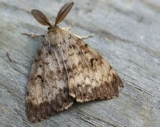
Gypsy moth
Overview
The gypsy moth, Lymantria dispar, is a moth
in the family Lymantriidae
of Eurasian origin. Originally ranging from Europe to Asia, it was introduced to North America in the late 1860s and has been expanding its range ever since. It is also known as the Asian gypsy moth.
Gypsy moth egg
masses are typically laid on branches and trunks of trees, but egg masses may be found in any sheltered location, particularly human dwellings, sometimes to the point of even nesting in clothes and footwear.
Lepidoptera
Lepidoptera is a large order of insects that includes moths and butterflies . It is one of the most widespread and widely recognizable insect orders in the world, encompassing moths and the three superfamilies of butterflies, skipper butterflies, and moth-butterflies...
in the family Lymantriidae
Lymantriidae
Lymantriidae is a family of moths. Many of its component species are referred to as "Tussock moths" of one sort or another. The caterpillar, or larval, stage of these species often has a distinctive appearance of alternating bristles and haired projections...
of Eurasian origin. Originally ranging from Europe to Asia, it was introduced to North America in the late 1860s and has been expanding its range ever since. It is also known as the Asian gypsy moth.
Gypsy moth egg
Egg (biology)
An egg is an organic vessel in which an embryo first begins to develop. In most birds, reptiles, insects, molluscs, fish, and monotremes, an egg is the zygote, resulting from fertilization of the ovum, which is expelled from the body and permitted to develop outside the body until the developing...
masses are typically laid on branches and trunks of trees, but egg masses may be found in any sheltered location, particularly human dwellings, sometimes to the point of even nesting in clothes and footwear.
Unanswered Questions

